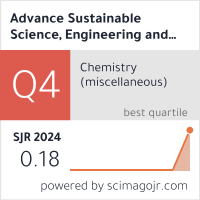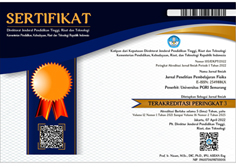Enhancing Biology Students’ Mastery of Animal Anatomy with a Web-Based Electronic Atlas: Toward Sustainable Digital Learning Tools
DOI:
https://doi.org/10.26877/asset.v7i3.1952Keywords:
e-atlas, flipped classroom, N-gain, web-based learning, sustainable education, anatomy learningAbstract
Learning animal anatomy in higher education often suffers from limitations in terms of visual media and practical time. Technology-based solutions such as web-based electronic atlases (e-atlases) can improve conceptual understanding and support digital continuous learning. This study aims to evaluate the effectiveness of web-based e-atlas in improving biology students' animal anatomy learning outcomes through a flipped classroom approach. This study used the ADDIE development model and a quasi-experimental design with a pretest-posttest control group approach. A total of 130 third semester students from three universities in Yogyakarta were divided into control (n=64) and experimental (n=66) classes. Instruments in the form of objective tests were validated by experts, and data were tested using Gain Score, N-gain, and t-test with parametric assumptions. The experimental class using e-atlas showed a significant increase in learning outcomes (N-gain=0.75; high category) compared to the control class (N-gain=0.29; low category), with significant differences based on t-test (p<0.001). These results support that e-atlas integration is effective in improving students' anatomical literacy. The use of web-based e-atlas in flipped classroom learning is effective, efficient, and has the potential to support the sustainability of biology learning. The findings recommend continued development of digital media to expand access and reduce reliance on physical animal dissection.
References
[1] Velásquez J, da Silva LLC, Miglino MA. Development of an Online Distance Learning Platform Combining Anatomy, Imaging, and Surgical Practice to Support Mastery Learning of the Equine Locomotor Apparatus. Journal of Veterinary Medical Education 2022;50:252–7. https://doi.org/10.3138/jvme-2022-0006.
[2] Ortadeveci A, Ermez MN, Oz S, Ozden H. A survey study on distance anatomy education: challenges unique to anatomy. Surgical and Radiologic Anatomy 2022;44:41–7. https://doi.org/10.1007/s00276-021-02772-z.
[3] Patton KT, Bell FB, Thompson T, Williamson PL. Anatomy & Physiology with Brief Atlas of the Human Body and Quick Guide to the Language of Science and Medicine-E-Book: Anatomy & Physiology with Brief Atlas of the Human Body and Quick Guide to the Language of Science and Medicine-E-Book. Elsevier Health Sciences; 2022.
[4] Martin JF, Arnold OR, Linton A, Jones JD, Garrett AC, Mango DW, et al. How virtual animal anatomy facilitated a successful transition to online instruction and supported student learning during the coronavirus pandemic. Anatomia, Histologia, Embryologia 2023;52:36–49.
[5] Oktafiyani A, Widiyaningrum P. Development of E-Atlas Anatomy of the Vertebrate Digestive System as a Teaching Material Supplement to Improve Student Learning Outcomes. Journal of Biology Education 2024;13:265–72.
[6] Priyambodo W. Electronic Atlas Morphological and Anatomical Structure of Little Egret’s Cervical Bones as A Biology Learning Media. Proceeding International Conference on Religion, Science and Education, vol. 2, 2023, p. 21–3.
[7] Anjomshoaa H, Ghazizadeh Hashemi AH, Jasim Alsadaji A, Jasim Mohammed Z, Masoudi S. The effect of flipped classroom on student learning outcomes; an overview. Medical Education Bulletin 2022;3:431–40. https://doi.org/10.22034/meb.2022.332357.1052.
[8] Gopalan C, Daughrity S, Hackmann E. The past, the present, and the future of flipped teaching. Advances in Physiology Education 2022;46:331–4.
[9] Sablan JR, Prudente M. Traditional and flipped learning: Which enhances students’ academic performance better. International Journal of Information and Education Technology 2022;12:54–9.
[10] Joy P, Panwar R, Azhagiri R, Krishnamurthy A, Adibatti M. Flipped classroom – A student perspective of an innovative teaching method during the times of pandemic. Educación Médica 2023;24:100790. https://doi.org/https://doi.org/10.1016/j.edumed.2022.100790.
[11] Ernawati E, Alonemarera AS, Sari TM. The critical thinking skills and independent learning analysis: The flipped classroom based on blended learning. JPBIO (Jurnal Pendidikan Biologi) 2022;7:253–63.
[12] Talbert R, Bergmann J. Flipped learning: A guide for higher education faculty. Routledge; 2023.
[13] Wang C-Y, Yin T, Ma K-H, Shyu J-F, Cheng C-P, Wang Y-C, et al. Enhancing anatomy education through cooperative learning: harnessing virtual reality for effective gross anatomy learning. J Microbiol Biol Educ 2023;24:e00100-23.
[14] Gianotto I, Coutts A, Pérez-Pachón L, Gröning F. Evaluating a Photogrammetry-Based Video for Undergraduate Anatomy Education BT - Biomedical Visualisation: Volume 16 ‒ Digital Visualisation in Biomedical Education. In: Border S, Rea PM, Keenan ID, editors., Cham: Springer International Publishing; 2023, p. 63–78. https://doi.org/10.1007/978-3-031-30379-1_4.
[15] Xiao J, Adnan S. Flipped anatomy classroom integrating multimodal digital resources shows positive influence upon students’ experience and learning performance. Anat Sci Educ 2022;15:1086–102.
[16] Akram H, Yassir M. THE EFFECTIVENESS OF MOBILE LEARNING APPS IN PLANT ANATOMY INSTRUCTION. Journal Informatic, Education and Management (JIEM) 2024;6:82–95.
[17] Naing C, Whittaker MA, Aung HH, Chellappan DK, Riegelman A. The effects of flipped classrooms to improve learning outcomes in undergraduate health professional education: a systematic review. Campbell Systematic Reviews 2023;19:e1339.
[18] Ngitung R, Elis P, Hartono H. The Effectiveness of Adding Seaweed to Feed in Reducing Fat and Cholesterol Levels in Broiler Chickens 2022.
[19] Okoye K, Hosseini S. T-test Statistics in R: Independent Samples, Paired Sample, and One Sample T-tests BT - R Programming: Statistical Data Analysis in Research. In: Okoye K, Hosseini S, editors., Singapore: Springer Nature Singapore; 2024, p. 159–86. https://doi.org/10.1007/978-981-97-3385-9_8.
[20] Wadhwa RR, Marappa-Ganeshan R. T test. StatPearls [Internet], StatPearls Publishing; 2023.
[21] Nurhayati I, Saputro GE. Differences in Learning Outcomes Between Conventional Learning and Video Tutorial Learning in Traditional Bun Courses. Atlantis Press SARL; 2024. https://doi.org/10.2991/978-2-38476-198-2_67.
[22] Bruen C, Illing J, Daly R, Meagher F, Delany C, Offiah G, et al. Medical student experiences of Case-Based Learning (CBL) at a multicultural medical school. BMC Medical Education 2025;25:152. https://doi.org/10.1186/s12909-024-06585-7.
[23] Fiandini M, Nandiyanto ABD, Al Husaeni DF, Al Husaeni DN, Mushiban M. How to calculate statistics for significant difference test using SPSS: Understanding students comprehension on the concept of steam engines as power plant. Indonesian Journal of Science and Technology 2024;9:45–108.
[24] Chung E-K, Yun H, Nam K-I, Cho Y-S, Han E-R. The application of flipped learning to a gross anatomy dissection course. Plos One 2024;19:e0298067.
[25] Vertemati M, Zuccotti GV, Porrini M. Enhancing Anatomy Education Throu€ gh Flipped Classroom and Adaptive Learning A Pilot Project on Liver Anatomy. Journal of Medical Education and Curricular Development 2024;11:23821205241248024.
[26] Demirçalı S, Selvi M. Effects of Model-Based Science Education on Students’ Academic Achievement and Scientific Process Skills. Journal of Turkish Science Education 2022;19:545–58. https://doi.org/10.36681/tused.2022.136.











